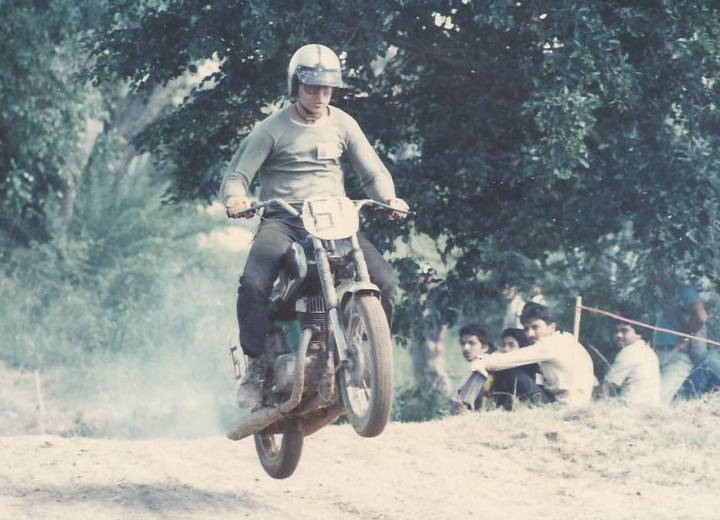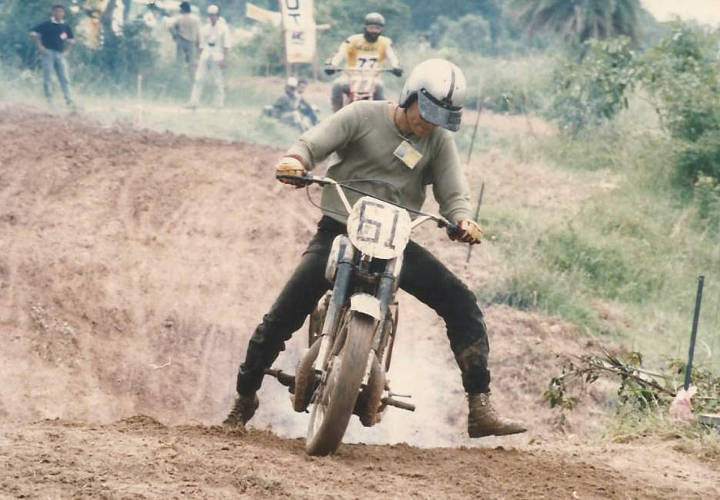"Tell us something about yourself that we don’t know yet."
This request was addressed to me several years ago, during an informal chat with a large assembly of HR personnel. I was then leading a global team in an engineered products organization. This was part of a monthly routine where senior executives from the organization were invited as guest speakers to talk about their work and perspectives on business.
On a whim I spoke about my decades-old passion for motorcycles - back in the 1980s it led me to a short stint of competitive riding on road and dirt tracks and remains as a lasting love for touring on two wheels. Along the way I gained great experiences, met wonderful people, broke a few bones and also learnt some elemental life lessons that have parallels in our work life. I learnt that racing improves the breed. On track or in organizations, competition is the essential friction that brings forth progress and performance; it improves what it touches, including people and skills.
On track or in organizations, competition is the essential friction that brings forth progress and performance.

[Do the reconnaissance: Riding a Yezdi 250cc motorcycle in a motocross event in Bangalore in the mid 1980s. Unseen dips in the track, curves, patches of loose soil and slush can cause very unsettled rides]
Lesson 1: Walk the track
I remember making unplanned excursions off the track in my early racing days, much to my embarrassment and the onlookers' amusement. Unseen dips in the track, curves, patches of loose soil and slush caused very unsettled rides as I fluctuated between all-out acceleration and panic braking. I realized only later that seasoned riders walk/ride the track before an event to familiarize themselves - an elementary step that I had overlooked. This simple preparation helped my performance. Knowing the track didn't guarantee a win, but certainly increased confidence and helped plan tactics.
Getting to know the new - be it business, team, audience or management - before you take on a major responsibility, is similarly critical. It can substantially improve chances of acceptance, collaboration, support and eventual success.
I learnt this lesson all over again as a young manager making my maiden pitch to the vice president of sales. I set before him a forceful path to reduce inventory and thereby improve cash flows. His response? Largely silent and unexcited. In his closing note he explained that customers were satisfied with product quality and reliability but demanded far shorter supply lead times. The clear need was to meet customers' expectations through quicker delivery, even if that demanded more strategic inventory.
A year later he was back in India. This time around I had done my scouting. Margins were in focus due to competitive pressures and extended receivables. My pitch on aggressive inventory reduction was well received - the same situation and audience, but remarkably different outcomes.
Some discreet enquiries are often all it takes. Speaking to the people who have been there helps gain insights. Old colleagues and the organization grapevine can provide valuable information on unique mindsets, biases, approaches.
Old colleagues and the organization grapevine can provide valuable information on unique mindsets, biases, approaches.
Lesson 2: Risks, rewards and staying alive
My early forays into competitive riding were on the dirt track. Racing on a dirt track is often volatile, unpredictable and even dangerous. You learn with hard experience whether a manoeuvre will lead to a win or a loss. Being reckless and riding beyond skill levels can lead to a broken machine and painful upsets, yet going slow isn’t an option. I realized that to win, I'd need to improve my skills and take studied chances. Balancing between 'too much' and 'too little' risk was key.
The same applies when you take on new projects, business lines, virgin regions, or broken teams and businesses. You need the mindset, skills and expertise to deliver. The rewards are great too, as assuming such leadership roles can lead to higher visibility, recognition and growth.
As a supply chain head my strident demands for an organization-wide manufacturing resource planning (MRP) system led to an unexpected outcome: I was given the challenge to set it up myself.
My initial thought was to decline, as I lacked any credible information technology (IT) skills and experience. While successful deployment would mean growth and gaining a new set of valuable skills, failure would have organization-wide visibility too. However, a quick assessment showed that it was a risk worth taking. I could largely leverage my core supply chain knowledge, bank on the regional IT team, and hire some more people locally.
Months of hard work followed, including a crash course in technologies, identifying and hiring team members with the requisite skills and managing stakeholders' expectations. The effort and investment paid off a year later and the deployment received recognition from the national IT community as a benchmark in leveraging IT for driving business performance.
Each such challenge has been stressful for sure, but has yielded great learning and growth. Of course, I have come unstuck at times and wondered why I did venture into uncharted waters, but it has also driven home the point that winning requires one to constantly improve skills and take studied chances. Which doesn't mean being stupid - you weigh in your experience, expertise, acceptable loss and available safety nets before you take the risk.
Winning requires one to constantly improve skills and take studied chances.
Lesson 3: Slow in, fast out
A race is won or lost on the curves and rough bits of the track. You need nimble agility on the curves to maintain your speed. I leant this during rally events that were conducted on a mix of paved and unpaved roads. Going into a sharp turn with the same speed as on the straight stretches, and coming upon unseen loose gravel or broken surface, could cause panicked corrections on throttle and brake - inelegant, time consuming and mortally dangerous.
A race is won or lost on the curves and rough bits of the track.
I observed that the best riders gained positions over the curves and rough bits with seemingly no fuss. They slowed a little and rode on the outer edge of the track before entering the turn. This let them see deep into the turn before committing to an entry line and speeding up again. I call this making haste, slowly. I did better once I consciously learnt to check my speed and select a line before entering the turn. Having taken the turn safely, with a better view of the path and exit, it was easier to power through forcefully, resulting in faster times and less drama.
Rushing headlong into a changing business/career situation is much the same. Transitions are commonplace and necessary; the urgency to show tangible results, a given. The outcomes - resounding success or failure - depends on how you set up the entry and keep sight of the desired exit.
I recollect addressing the employees of a newly added business where I had stepped in as lead. Eager to show early successes, I spoke to them passionately about the future directions and objectives, only to be met with silence and hesitant nods from a team that hadn’t seen a leadership change in decades. I decided to take two steps back and spent the next several weeks speaking with team members about their earlier experiences, successes, anxieties and needs. I did my best to assuage their anxieties about the future of the business and also explained how the changes would benefit all. With that addressed, the platform was now set to initiate the changes. This time the team was supportive, aligned to the goals and even excited.
Gaining firm footing in a new situation or setting, before making major changes in direction and velocity, are crucial. This allows time to build support for the changes and help prepare an environment to understand the hidden 'why' behind the explicit 'what'.

[Balance risks and rewards: The Yezdi with a broken front shock absorber in the midst of a motocross event in the mid 1980s. Being reckless can lead to a broken machine and painful upsets.]
Lesson 4: Counter-steering
After I gave up racing and moved to a heavier, more powerful machine for long distance touring, I had to relearn a few techniques - like turning at speed. Turning a lighter motorcycle is intuitive - you steer in the direction of the turn. The first time I tried to turn my new motorcycle, it was like wrestling a reluctant pig. The 200+ kg machine resisted my efforts, while I rapidly ran out of road. Heart-stopping seconds later, I did manage to turn it and bring it to a halt. Baffled and seeking answers, I learnt that to turn left, it was far easier if I gently turned the handle to the right! This is counter-intuitive for sure, till I learnt why and how. Gyroscopic forces tend to keep the motorcycle from deviating from its path–especially true for heavy machines at higher speeds. I tried counter-steering hesitatingly, and revelation! The machine eagerly dipped in the desired direction and executed a tight turn.
A direct approach and clear sight of the objective is the mark of a professional. Straight in and out. Clinical perfection. Yet, at times it's necessary to take a less obvious approach. As a procurement professional, negotiation was a way of life. Going in to discus business with a monopoly supplier, I had been cautioned that I would face a difficult owner who recognized our dependence and wouldn’t share information, much less negotiate. I decided to forgo the usual buyer-seller discussions and focus on introductory discussions. I learnt that the owner harboured a desire to grow in emerging markets, but lacked the local knowledge and contacts to do so. I offered to help him identify suitable local partners in emerging markets. Doors opened and I ended up gaining a tour of the manufacturing facilities, detailed explanation of processes and a cordial platform set for further business negotiations.
A direct approach is the mark of a professional. Yet, at times it's necessary to take a less obvious approach
There are more ways than one to achieve an end. Understanding underlying forces, intentions and needs is key to success. Aligning with apparently opposing elements can also be a strategy.
Lesson 5: Don’t be a DNF (did not finish)
DNF is the brief notation that identifies a competitor who did not complete the course, for whatever reason. Staying in the race, even with a broken body and machine, goes beyond mental toughness and passion. It allows you to gain crucial experience for the next time. It’s also sound logic, as it keeps open a window of opportunity - anything can happen in the last few minutes of the race; a race leader could run into trouble too.
Staying in the race keeps open a window of opportunity - anything can happen in the last few minutes of the race.
One of the toughest choices many of us face is when to walk away from a project. We have given it our best but results and recognition are not forthcoming. Should we stay invested or abort? I remember emerging from a challenging half-year appraisal; our results were lagging due to several factors, despite best efforts. The yearend appraisal loomed ominously a few months ahead. Recognising that the fundamental strategy was solid, I chose to change tactics, intensified outreach to business partners and brought forward projects that were scheduled for later in the year. Meanwhile, extraneous factors - exchange rates and commodity prices - that were headwinds earlier, swung in favour and we ended the year above target.
Clearly, not every such effort would end as happily if the basic plan and tactics are flawed or the negative factors are overpowering.
Having said that, stick with the plan and objective, especially when the going is rough. Tweak midcourse settings if needed. Seek support. Organizations reward results but also value efforts and innovative thinking. Customers dislike failures but respect clear intentions and quick recoveries. Abort if there are fatal flaws in strategy and deployment that can’t be fixed. Seek new challenges.
Lesson 6: Even the best riders fall
Finally, no discussion on motorcycles could be complete without discussing the dreaded ‘F’ word - what happens if one falls?
Two-wheelers are prone to do that, especially when flung around at speed. The fear of falling is an anxiety for a new rider and can be paralysing, resulting in playing it safe. This behaviour, unfortunately, will not lead to a stellar closing position or help improve riding skills.
Even the best riders fall, occasionally. If you never fall, it's likely that you aren't trying hard enough to go faster. What differentiates the best riders is their ability to clinically judge their limit of control over the motorcycle - how hard they can push without losing traction - and constantly raise this limit through practice. And if they fall, they roll, recover and get back on the saddle - all while still hurting from an upset.
If you never fall, it’s likely that you aren't trying hard enough to go faster.
On the track or in organizations, failure - and even worse, the fear of failure - can limit opportunity and performance. Failure is a possible outcome of endeavour. Undesirable, but still possible. Over-prepare to pre-empt it. Deal with it if it happens. Learn from it. And then get back in the fray! Action is a great way of dealing with emotions and regaining control of oneself.
Failure is a possible outcome of endeavour. Deal with it. Learn from it. And then get back in the fray!
Competition is a constant from the cellular level to people, organizations and nations. Recognize, accept and embrace it. Prepare, train and take the necessary risks wisely. Check for damage and dust yourself if unseated. Remount.

